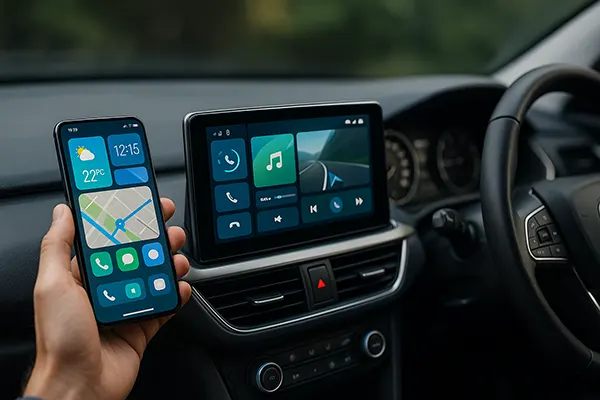Adaptive User Interfaces: From Smartphones to Automotive Systems

Adaptive user interfaces have become a critical component of modern digital design. As devices diversify and users expect consistent usability across form factors, adaptive interfaces bridge the gap between technology and everyday experiences. By 2025, the demand for intelligent, context-aware interfaces has grown significantly, particularly across mobile ecosystems and the automotive industry.
The Evolution of Adaptive Interfaces
The evolution of adaptive interfaces began with early attempts to optimise layouts for different screen sizes. As smartphones became more capable, designers shifted towards flexible structures capable of responding dynamically to orientation, resolution and user preferences. This shift laid the foundation for systems that adjust not only visually, but also functionally.
By the early 2020s, adaptive interfaces had transitioned from simple responsive layouts to systems driven by behavioural data. These interfaces learned from user actions, adapting navigation paths, recommended features and interface density to reduce friction and support accessibility. This created a pathway towards more personalised interactions across devices.
In 2025, the concept has matured into adaptive ecosystems. These systems recognise environmental contexts — such as motion, lighting conditions and user habits — allowing interfaces to adjust automatically. Whether switching between work and leisure modes or transitioning from handheld to hands-free operation, adaptive systems aim to provide stability without overwhelming the user.
Key Principles Behind Modern Adaptation
The success of adaptive interfaces depends on how effectively they interpret context. Designers rely on data from sensors, activity tracking and system analytics to identify patterns that influence layout and behaviour. These elements ensure that the interface responds to real needs rather than arbitrary conditions.
Accessibility standards also influence adaptive design. Users with mobility limitations, visual impairments or cognitive challenges benefit from interfaces that adjust font sizes, contrast levels or navigation complexity automatically. In 2025, international regulations increasingly require digital products to offer adaptive support rather than static accessibility modes.
Another essential principle is transparency. Users must understand how and why an interface changes. Clear communication, predictable behaviour and optional manual controls foster trust, which is especially important in safety-critical environments such as vehicles and connected devices.
Adaptive Interfaces on Smartphones
Smartphones remain the leading environment where adaptive interfaces are continuously refined. Modern operating systems integrate machine-learning tools that analyse user behaviour throughout the day. This allows devices to optimise home screen layouts, prioritise information widgets and adjust notification styles based on context.
Screen real estate plays a central role. Foldable smartphones, widely adopted by 2025, require interfaces that seamlessly transition between compact and expanded modes. Applications must restructure content flows, reposition interactive elements and recalculate text density to ensure comfort in both single-handed and tablet-like layouts.
Battery efficiency also shapes adaptation strategies. Interfaces reduce animation intensity, modify colour temperature or switch to simplified modes during low-power scenarios. These adjustments help maintain usability without sacrificing essential functions, especially for users who rely on their phones throughout the workday.
Behaviour-Driven Mobile Adaptation
Behaviour-driven adaptation enhances usability by learning long-term patterns. For example, smartphones may rearrange frequently used applications at certain times or prioritise navigation tools during commuting hours. This approach reduces cognitive load and shortens interaction time.
Gesture systems have also improved. Interfaces adjust gesture sensitivity depending on hand position, grip strength and device orientation. This reduces accidental actions and improves accuracy, particularly on larger or flexible displays.
Privacy-focused adaptation is equally important in 2025. Smartphones modify notification previews, voice assistant activation sensitivity and on-device personalisation depending on proximity sensors, location and the presence of others. These refined strategies support personal boundaries without requiring constant manual adjustments.

Adaptive Interfaces in Automotive Environments
In vehicles, adaptive interfaces must address heightened safety requirements. Automotive HMIs (Human–Machine Interfaces) adjust content visibility, layout complexity and interaction modes based on driving conditions. Speed, steering behaviour and ambient lighting influence how information is presented to minimise distraction.
Voice control systems now adapt dynamically as well. They reduce menu depth while driving and restore full functionality when the vehicle is stationary. This ensures quick access to essential features while maintaining compliance with international safety guidelines and automotive UX standards.
With the expansion of electric and connected vehicles, interfaces also react to environmental data such as range, route conditions and energy consumption. Drivers receive context-aware suggestions, driving tips and interface changes tailored to current performance requirements, enhancing both convenience and safety.
Future Trends in Vehicle Adaptation
In 2025, adaptive automotive interfaces increasingly use biometric data. Pulse rate, eye movement and driver engagement metrics inform adjustments to screen brightness, alert sensitivity and interface density. These systems support early detection of fatigue or distraction and adjust the interface to maintain driver focus.
As autonomous features expand, vehicles introduce dual-mode interfaces that shift seamlessly between driver-assist and semi-autonomous states. When the system takes control, the interface may expand entertainment options, present detailed journey information or provide system health updates.
Cross-device synchronisation is another emerging trend. Vehicles recognise user profiles from smartphones or wearable devices and automatically adjust personalised settings — seat preferences, lighting themes, preferred navigation routes and interface scale — creating a cohesive multi-device ecosystem.
